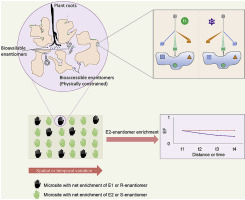Environmental Research ( IF 8.3 ) Pub Date : 2020-03-10 , DOI: 10.1016/j.envres.2020.109354 Edmond Sanganyado 1 , Zhijiang Lu 2 , Wenhua Liu 1

|
The assumption that only biological processes are enantioselective introduces challenges in the reliability of enantioselective analysis as a tool for discriminating biotic and abiotic processes in the environmental fate of chiral pollutants. Enantioselectivity does not depend on the nature of the fate process a chiral contaminant undergoes but on the interaction of the chiral contaminant with homochirality inducing external agents (e.g. chiral molecules, macromolecules or surfaces such as enzymes, blood plasma, proteins, chiral co-pollutants, humic acid and soil organominerals). The environmental behavior of a chiral contaminant is difficult to anticipate because the interactions between the chiral contaminants and the homochirality inducing external agents is often complex and strongly influenced by local environment conditions such as pH, redox conditions, organic carbon, organic nitrogen, humic acid, and redox conditions. Furthermore, the use of enantioselective analysis in environmental forensics depend on the adequate separation and accurate identification and quantification of the enantiomers of the chiral contaminant. Matrix effects, instrument effects, inadequate enantioselective separation, and poor quantification techniques introduce uncertainties in the determination of enantiomeric composition. Here we present the weaknesses of this assumption and recommend using enantiomeric fractions as chemical markers of biotransformation with caution. We recommend using stable isotopes, including abiotic controls to determine if enantioselective sorption occurs, and determining stability of enantiomers in solvent or at elevated temperatures to account for confounding factors arising from matrix effects, enantioselective abiotic processes, and enantiomerization due solvent and thermal lability of the chiral analyte, respectively to maintain the integrity of the utility of enantiomeric composition changes as an environmental forensics tool.
中文翻译:

对映体馏分在环境取证中的应用:不确定性和不一致之处。
仅生物过程是对映选择性的这一假设提出了对映选择性分析作为区分手性污染物环境命运中的生物过程和非生物过程的工具的可靠性方面的挑战。对映选择性不取决于手性污染物所经历的命运过程的性质,而是取决于手性污染物与诱导同手性的外部因素(例如手性分子,大分子或表面,如酶,血浆,蛋白质,手性共污染物,腐殖酸和土壤有机矿物质)。手性污染物的环境行为难以预料,因为手性污染物与诱导同手性的外部因素之间的相互作用通常很复杂,并且受当地环境条件(例如pH,氧化还原条件,有机碳,有机氮,腐殖酸和氧化还原条件。此外,在环境取证中对映选择性分析的使用取决于手性污染物的对映异构体的适当分离,准确鉴定和定量。基质效应,仪器效应,对映体选择性分离不足以及定量技术不佳,在确定对映体组成时存在不确定性。在这里,我们介绍了这一假设的弱点,并建议谨慎使用对映体级分作为生物转化的化学标记。我们建议使用稳定的同位素(包括非生物对照物)来确定是否发生对映选择性吸附,



























 京公网安备 11010802027423号
京公网安备 11010802027423号